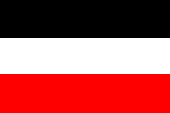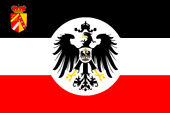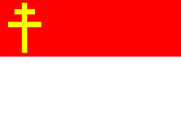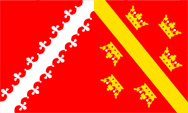




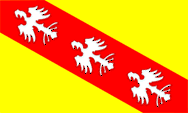
historical flag of Lorraine,
Source, by: Flags of the World






The colours of Alsace-Lorraine corresponded initially to the colours of the German Empire (1871–1918): black, white and red. They characterize Alsace-Lorraine as empire's country, so as nonfederal, central administrated element of the empire.
On the 29th of December in 1891 was introduced an official flag for the empire's country Alsace-Lorraine on the base of the empire's official flag for the foreign office. For differentiation it shows the crowned coat of arms Alsace-Lorraine in the black stripe in the leech.
Alsace-Lorraine had, compared with the other countries of the German Reich quite equal rights. It had its own elected parliament (Landtag), its own provincial administration, its own government, its own constitution. However, in contrast to the other countries of the German Empire (except the Hanseatic cities) there was no ruling prince. Since 1911 there was in discussion a still young member of the ruling house of Baden as prince of Alsace-Lorraine, which should be eventually proclaimed or confirmed by the parliament. With the outbreak of war, there however rised other priorities.
On 25th of June in 1912 the Landtag (Parliament) of the imperial province of Alsace-Lorraine passed unanimously the by a committee developed proposal of a red-white striped flag whith an yellow Lorraine Cross in the left upper corner. This act was never implemented by the imperial authorities, so that there was no change. But the flag was often used for private and semi-official occasions. It was not well received by the German authorities and the military, but was also partly tolerated during the First World War. This flag was a combination of the colors of Alsace (red and white) and Lorraine (red and gold).
At the end of the war, with the withdrawal of the German troops, the Republic of Alsace-Lorraine was proclaimed on 11th of November in 1918, hoping for independence but also protecion from France and the German Empire, however, the republic startet to transform into a Soviet Republic. Thereupon French troops were called in to help, who finished the Soviet Republic under the applause of the population. The Republic of Alsace-Lorraine took over the in 1912 created unofficial flag of the imperial province of Alsace-Lorraine.
Source: Ronald Preuß, Jürgen Kaltschmitt

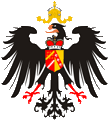
1871–1918,
Coat of arms of Alsace-Lorraine,
Source, by: Wikipedia (D)

1871–1918,
Blazon of Alsace-Lorraine
Source, by: Flags of the World

The coat of arms of the empire's land Alsace-Lorraine depicts the empire's eagle without Prussian shield and official chain of an order. The empire's eagle is covered with a princely crowned shield, which is clefted and in front divided. In front above appears the coat of arms of the Landgraviate of Upper-Alsace (golden diagonal with twice three golden crowns on red ground), below the coat of arms of the Landgraviate of Lower-Alsace (white diagonal bar with egdes in lily cut on red ground). In the second half is positioned the coat of arms of the Duchy of Lorraine (red diagonal with three crippled silvery eagles – named Alérions – on golden ground).
Source: Ronald Preuß

Map of Alsace-Lorraine:
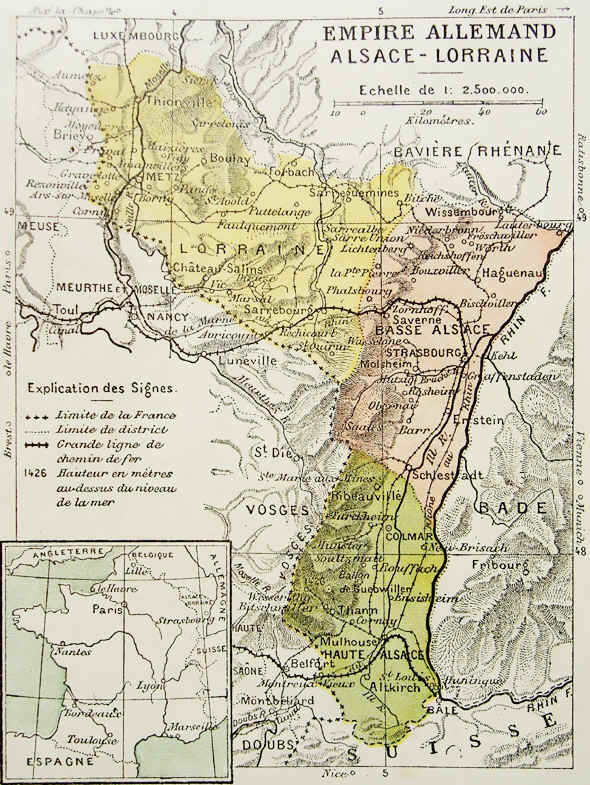
Source:
Wikimedia, By Of the photography : ComputerHotline [Public domain],
via Wikimedia Commons

Area: 5.607 square miles
Inhabitants: 1.874.000 (1910)
Density of Population: 330 inh./sq.mi. (1910)
Capital: Straßburg (Strasbourg)
Sprachen (1910): 87% German, 12% French
Religions (1910): 76% Roman Catholic, 22% Protestant
Source: Wikipedia (D)

• History of Alsace → tap here
• History of Lorraine → tap here
History of Alsace–Lorraine:
1870–1871 · German-French War, battles of Gravelotte and Spichern, German victory in five months, on 18th of January in 1871 will be proclaimed the German Empire at Versailles, peace treaty on 26th of February in 1871, France has to cede to the German Empire Alsace and parts of Lorraine (Meurthe Departement, Arrondissements of Saarburg and Chateau-Salins), establish of the Imperial Province of 'Alsace-Lorraine'
1871–1873 · direct government by the Federal Council of the German Empire
1874 · first elections to the German parliament, formation of a National Committee for Alsace-Lorraine
1879 · installation of a governor as head of Alsace-Lorraine
1911 · the country gets its own constitution and gets equality among the other German states, first and last election for the parliament (Landtag) of Alsace-Lorraine, adopting of an own national anthem: "Das Elsäßische Fahnenlied" (Alsacian flag-song)
1914–1918 · First World War, the western front passes through Upper Alsace
11th of November 1918 · Armistice of Compiègne, Alsace-Lorraine is to vacate by German troops within 15 days, with the withdrawal of the German troops, the Republic of Alsace-Lorraine was proclaimed, but startet to transform into a Soviet Republic, French troops were called in to help, who finished the Soviet Republic
17th–21st of November 1918 · French troops marching in, in Muehlhausen (Mulhouse), Colmar, Metz and Strassburg (Strasbourg)
17th of October in 1919 · dissolution of Alsace-Lorraine by France, 200.000 after 1870 immigrated Germans have to leave the country, after an appeal of the USA it was allowed to return for the half
Source: Atlas zur Geschichte,
Wikipedia (D),
Jürgen Kaltschmitt

The origin of the name "Alsace" goes back to the period of the Frankish rule. There are two explanations: The name comes from the word "Elisassen" which means "foreign residents" (sassen = inhabitants), or from the word "Illsassen" what means: "the inhabitants of the banks of the Ill". The Ill (ILL) is a river that flows parallel to the Rhine in central Alsace, and flows into the Rhine 10 km north of Strasbourg. In French the land is called "Alsace".
The name Lorraine goes back to a grandson of Charlemagne (Charles the Great), Lothar I., who gets the central realm (from of Friesland to Italy) at the division of the Frankish Empire in 843 AD. The northernmost part of this kingdom was called "Lotharingen", probably the domain of Lothar. In the year 911 it has developed into the Duchy of Lorraine under Duke Reginar, which was divided, however, in 953 in Upper and Lower Lorraine. in the year 1106 the Duchy of Lower Lorraine was renamed in Duchy of Brabant, Upper Lorraine continued as Duchy of Lorraine to 1801. Parts of Lorraine became in 1871 part of the German Imperial Province of Alsace-Lorraine, which in 1918 – after the First World War – has to be ceded to France. In German the land is called "Lothringen".
Source: RetroBib Retrobibliothek







![]()

